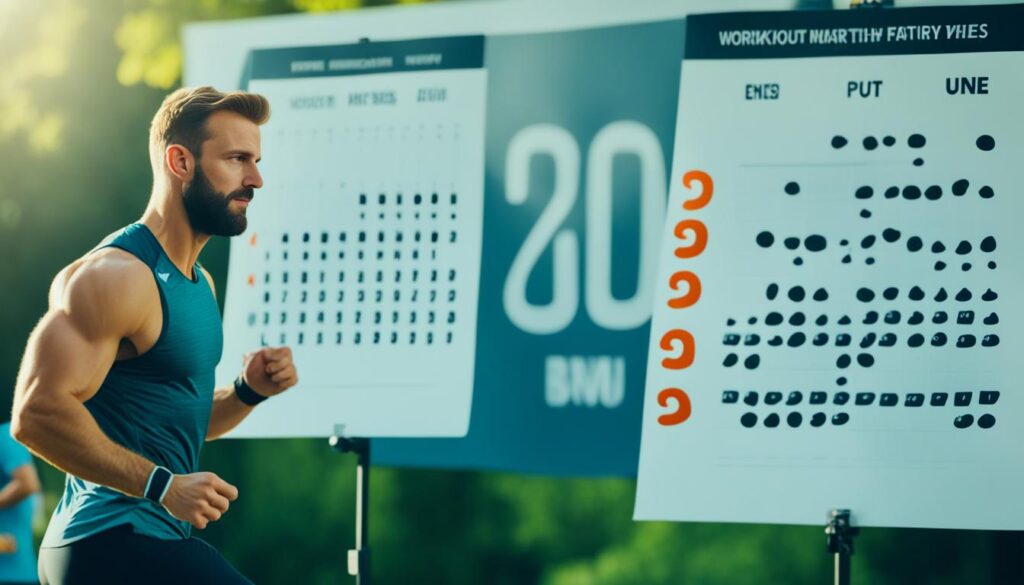Imagine the collective energy of over 20 million footsteps as runners, united by a common goal, cross 5K finish lines annually across the United States. In an increasingly health-conscious world, the 5K race stands as a testament to the indomitable human spirit and the power of starting small. This statistic isn’t just a number; it’s a narrative, one that every novice runner can be a part of. Whether your aim is to bolster your health, establish new social connections, or challenge your personal boundaries, embracing a beginner 5K training plan is your starting block to success.
Addressing the needs and questions of the first-time runner, we craft a roadmap consisting of **easy 5K training plans** and **first-time runner tips** to navigate the journey from **novice to 5K finisher**. The audacious goal of conquering 3.1 miles starts not with a leap, but with a single stride—yours. Let’s lace up those sneakers and ignite that runner’s high with a plan that propels you from your couch to the finish line, one exhilarating step at a time.
Welcome to Your First 5K: Embracing the Challenge
If you’ve decided to embark on a running journey, congratulate yourself! Taking the leap towards completing a 5K is both exhilarating and admirable. For many, the idea of running a race can be quite intimidating, but with the right 5K training program, you will find that it’s an enjoyable and deeply rewarding endeavor. This section is dedicated to guiding you through the initial stages of your training and helping you establish a solid running foundation.
Running plan for beginners does not only involve physical preparation but also includes a mental commitment to the challenge ahead. It’s crucial to approach this new routine with an understanding that the body will experience changes and embrace the soreness that comes with these beginnings as a sign of progress.
As you settle into your beginner running schedule, remember to give yourself four to six weeks of consistent training. This time frame is essential for your body to make noticeable physiological adaptations, making your runs more comfortable and, more importantly, more enjoyable.

Motivation is a critical component as you move forward. Use the following points to stay engaged and encouraged through your journey:
- List your reasons for running a 5K and revisit them often.
- Track your progress and celebrate small victories.
- Connect with other beginners – support each other!
- Keep your goals realistic and manageable.
- Remember, rest is as important as the workouts – it’s when your body rebuilds and strengthens.
As you begin this new chapter, be patient with yourself. The path to your first 5K is unique and immensely personal. It is a challenge, but more than that, it is a journey of self-discovery and growth. Lace up your running shoes, set your sights on the path ahead, and take one step at a time towards crossing that finish line.
Understanding the Appeal: Why the 5K is Perfect for Beginners
The quintessential starting point for many, a 5K race, resonates with myriad beginner runners thanks to its thoughtful balance between challenge and feasibility. Reflecting on the allure of this event, the 5K distance emerges as both a milestone and a stepping stone in the universe of distance running—an invitation to a running journey that is accessible, rewarding, and remarkably versatile.

Defining the 5K Distance and Its Accessibility
Spanning a distance of just over 3 miles, a 5K is often celebrated as the optimal entry point for beginners. Its accessibility in running manifests not just in the physical distance but also in the mental approachability for novice participants. Cities from coast to coast present a wealth of beginner runner workouts, 5K programs, and races that embrace every season, ensuring that one’s first race is never too far out of reach.
Building Confidence Step by Step
Progress is the bedrock of any running journey, particularly for beginners. As first-timers lace up and hit the pavement, each stride sows the seeds of self-belief. Success in conquering the 5K distance inspires nascent runners to not only do it once but to keep pushing their boundaries—shaping their workouts to gradually increase in intensity as their fitness blooms. With each completed race and workout, runners forge an ever-growing confidence, propelling them toward greater achievements.
| 5K Journey Milestone | Workout Focus | Accessibility Factor |
|---|---|---|
| Week 1 – 2 | Acclimatization | Local Park Runs |
| Week 3 – 4 | Stamina Building | Accessible Online Guides |
| Week 5 – 6 | Speed Work | Community Race Events |
| Week 7+ | Endurance | Personal Achievement |
Pacing Your Progress: Run-Walk Method for Starters
If you’re taking your first steps into the exhilarating world of running, the run-walk method offers a supportive path toward building your stamina and embarking on a successful running routine. Specifically curated for first-time runners, this technique deftly combines intervals of running with brief periods of walking, making the prospect of building running endurance far less daunting.
By easing into the effort with one-minute running and walking intervals, you give your body the chance to adapt without feeling overwhelmed. It’s a balanced mix of intensity and recovery, designed to help you progress smoothly and efficiently from a brisk walk to a steady jog, and eventually, to a comfortable run.
With each step forward, the run-walk method allows you to listen to your body, customize your training, and relish the milestones of your fitness journey.

Let’s explore how the method evolves over time. Starting with one-minute intervals is just the beginning. As you grow stronger and more confident, you’ll naturally find yourself increasing the duration of the running segments while minimizing the walking breaks. This adaptable strategy keeps you consistently moving forward, matching your pace with your progressing endurance.
| Week | Running Intervals | Walking Intervals | Total Time |
|---|---|---|---|
| 1-2 | 1 min | 1 min | 20 min |
| 3-4 | 2 mins | 1 min | 25 min |
| 5-6 | 3 mins | 1 min | 30 min |
| 7+ | 4 mins | 1 min | 30 min |
- Adjust the plan based on how you feel
- Increase intervals incrementally
- Ensure a day of rest between sessions
To truly reap the benefits of the run-walk method as a first-time runner, remember that patience and consistency are indispensable. Celebrate every increment, whether that’s an extra minute of running or a longer total distance covered. By pacing your progress thoughtfully, you’ll transform the way you run and confidently cross the finish lines of your future.
Comprehensive Couch to 5K Programs and How They Work
Embarking on a couch to 5K plan is like setting out on a transformative journey that takes you from stationary to finish line freedom. Imagine engaging in a program that’s crafted with the unique needs of a newcomer to running in mind—one that not only encourages the habit of running but also fuses essential cross-training to preemptively combat the specter of injury.

For those contemplating their first 5K, here is a riveting 5K training tip for beginners: consistency over intensity. Indeed, your training duration typically spans eight to ten memorable weeks, often beginning with intervals of running and walking that gently invite your body to capture the cadence of a runner without haste.
By adopting gradual increases in running periods and strategically interspersing full-body strength-training programs, you’re not just training to run; you’re building a fortress of muscle and resilience.
Let’s not forget—life happens. You might miss a session here or there, and that’s perfectly okay. The beauty of these programs lies in their flexibility; offering modified recommencement plans that are forgiving and adaptable to your specific pace of life and fitness level.
- Fosters running efficiency through incremental training
- Integrates strength training to construct a robust physique
- Provides a framework that accommodates life’s unpredictable nature
In the table below, you’ll find a keen illustration of the shared components of a standard couch to 5K plan, juxtaposed with guidance for a balanced approach to 5K training for beginners. Harness this knowledge to calibrate your aspirations accordingly.
| Week | Run-Walk Ratio | Strength Training | Flexibility & Rest Days |
|---|---|---|---|
| 1-2 | 1 min run, 1.5 min walk (repeat) | Full-Body Circuits x2 | Yoga/Stretch Days x2, Rest Day x1 |
| 3-4 | 2 min run, 2 min walk (repeat) | Full-Body Circuits x2 | Yoga/Stretch Days x2, Rest Day x1 |
| 5-6 | 5 min run, 3 min walk (repeat) | Full-Body Circuits x2 | Yoga/Stretch Days x2, Rest Day x1 |
| 7-8 | 10 min run, 5 min walk (repeat) | Full-Body Circuits x2 | Yoga/Stretch Days x2, Rest Day x1 |
| 9-10 | Run for 30 mins or 5K | Full-Body Circuits x2 | Yoga/Stretch Days x2, Rest Day x1 |
As your trust in this process strengthens with every stride, you’ll come to witness the alchemy that is your burgeoning ability to not just jog, but to glide through distances that once seemed insurmountable. Thus begins your story: from the comfort of your couch to the jubilant crossing of a 5K finish line.
Essential Running Rules Every Beginner Should Know
Embarking on a running journey opens up a world of health and personal growth opportunities for beginners. To leverage these benefits fully, there are established rules of running for beginners that aim not only to improve running efficiency but also to create a positive and progressive running experience. Let’s explore these foundational rules that can set any novice runner up for success.
Commitment to Consistency Over Perfection
As a new runner, you might find that the road to improvement is not always a straight line. Keeping the focus on maintaining a consistent running regimen is more productive than pursuing the elusive idea of a perfect workout. It’s about showing up for yourself, run after run, and committing to the process, no matter the pace or distance.
Using Bad Days as Milestones for Growth
Every runner has off days, but rather than seeing them as setbacks, view them as an integral part of your training journey. These challenging moments provide crucial insights into your resilience and stamina, teaching you invaluable lessons to carry into your next run. It’s the bad days that often lead to the biggest strides in personal development.
| Rule | Purpose | Benefit |
|---|---|---|
| Listen to Your Body | Prevent Overexertion | Reduces Injury Risk |
| Stay Hydrated | Maintain Performance | Optimizes Efficiency |
| Rest and Recover | Allow Muscles to Repair | Ensures Longevity in Running |
| Follow a Plan | Structured Progression | Maximizes Training Output |
| Go at Your Pace | Personal Comfort | Customized Improvement |
While it is tempting to push through discomfort, one of the most important strategies to avoid running injuries is recognizing when your body is signaling for rest. Incorporate planned rest days and decrease intensity when needed to ensure you can continue to run and improve safely over time.
Remember, your running journey is unique, and these rules are not rigid directives but guidelines meant to shepherd your path to personal achievements and the joy of running.
Cornerstones of Training: 5K Tips for Starters
Embarking on a beginner 5K training journey can feel like a leap into the unknown, but with the right guidance, crossing that finish line is not just a dream—it’s an inevitable victory. Every stride you take is a building block toward your goal, and our essential tips will pave the way for a comfortable, rewarding race day.
One cornerstone of a successful beginner running schedule is indeed the mundane matter of hydration. Embrace the simple, yet profound, impact of staying hydrated while running. Our bodies are a complex network of cells craving water to function efficiently, especially during physical exertion. Encountering the challenge of a 5K demands a well-hydrated system to sustain endurance, ensure mental clarity, and prevent the adverse effects of dehydration.
- Select impeccable footwear that offers the finesse of both comfort and support.
- Develop a mantra that becomes your mental armor against the psychological demands of long-distance running.
- Consider the stats as a mere sketch, not the full painting, of your progress.
- Learn to distinguish the sustainable discomfort of growth from the sharp edges of potential injury.
Moreover, aspiring to increase running pace should be approached with thoughtful progress rather than impulsive haste. Your muscles, your breath, and even your heart find a rhythm that becomes more efficient over time. Indulge in cross-training activities to give your running muscles a well-deserved break while still enhancing your overall athletic performance.
Remember, beginners, that the zenith of your 5K journey—your first race day—is just the start. The expertise you cultivate through these training gems is not just about preparing you for the starting line or the tape across the finish – it’s about sculpting a lifestyle that cherishes movement, endurance, and the joy of running.
First-Time Runner Exercises: Building Strength and Endurance
Embarking on a 5K journey signifies more than just stepping out to run; it denotes a commitment towards enhancing your body’s capacity for building running endurance and muscular fortitude. For neophytes in the world of long-distance running, the incorporation of key first-time runner workouts and strengthening exercises for runners plays a pivotal role in achieving overall running efficiency.
As we delve into the exercise routines that will forge a robust running foundation, it is essential for runners to remember that strength does not solely derive from the legs. Core stability, upper body strength, and flexibility across all muscle groups play integral roles in a balanced and powerful stride. Hence, it’s advisable for those at the commencement of their running expedition to schedule multi-facetted training sessions focused on these objectives.
- Bodyweight squats and lunges forge leg strength and mobility, key for sustained running power.
- Planks and abdominal workouts improve core stability, enabling better posture and balance while running.
- Push-ups and pull-ups will augment your upper body, which helps maintain form over long distances.
Combining these components creates a versatile strength regimen that aids runners not only in the short bursts but also in the long haul, literally and metaphorically. The beauty of these exercises lies in their simplicity and the minimal requirement for equipment, making them accessible to virtually all aspiring runners.
Strength Training is not a mere addition to a runner’s training; it is the bedrock upon which endurance is built. – Renowned Coaches and Runners
Moreover, interval workouts that alternate between high-intensity bursts and active recovery periods teach the body to efficiently utilize oxygen and energy. These workouts can significantly contribute to both speed and endurance.
- Begin with a light jog to warm up the muscles.
- Proceed to run at a high intensity for 1-2 minutes.
- Follow with a 2-3 minute recovery jog or brisk walk.
- Repeat the cycle for a total of 20-30 minutes.
While diligently training the body to face the physical challenge of a 5K, do not neglect the tendons and joints, which will thank you for regular stretching and flexibility routines including yoga or dynamic stretching.
With a strategic approach to first-time runner exercises, your progression from novice to 5K finisher will be marked by strength, stamina, and a newfound appreciation for the capabilities of your own two feet. Dedicate the time, harness the perseverance, and relish the transformation as each stride propels you closer to your goal.
First Step to the Finish Line: Starting a Running Routine
Embarking on a running journey starts with the brave decision to step into new territory, setting an ambitious yet attainable goal like finishing a 5K. The transformative power of starting a running routine should not be underestimated—it’s the catalyst for an adventure that enhances both physical and mental fortitude. For those wondering how to begin, a beginner 5K training plan for first-time runners could be your roadmap to success.
Consistency is key and lays the groundwork for an effective exercise program for 5K. Here is where training consistency not only builds stamina but also forges the mental resilience necessary to push through future challenges. A beginner’s journey invites individuals to start where they are, using manageable activity blocks like walking, that will soon evolve into a fluid, energizing run.
Outlined below is a 4-week beginner’s guide, perfect for fostering training consistency while introducing the joys and rewards of running.
| Week | Activity | Duration | Notes |
|---|---|---|---|
| 1 | Daily Walks | 20 mins | Gentle pace to build habit |
| 2 | Walk/Run Intervals | 30 mins | Alternate 5 mins walking, 2 mins running |
| 3 | Increased Run Intervals | 30 mins | Alternate 4 mins walking, 3 mins running |
| 4 | Consistent Run | 20 mins | Assess comfort and increase duration as able |
A discipline as elemental as running reaps bountiful rewards—improved cardiovascular health, heightened self-esteem, and the exhilarating sense of freedom as you coast through each mile. With patience and adherence to a beginner 5K training plan, first-time runners will soon find themselves at the starting line, heartbeats syncing with the anticipatory countdown, ready to embark on a race that once seemed like a distant dream.
Smart Training: Balancing Running, Rest, and Cross-Training
Embarking on a beginner’s running plan requires an appreciation for the symbiotic relationship between exertion, rest, and varied physical activity. Setting out with the goal of completing a 5K is both laudable and attainable when the approach to training is both comprehensive and considerate of the body’s need for recovery. Integrating rest days into your routine isn’t a mere suggestion; it’s a fundamental aspect of building your endurance without inviting injury.
The Vital Role of Recovery
When devising a running plan for beginners, it is vital to underline the importance of recovery. These periods of rest are as critical as the training itself, with the power to repair and strengthen your body. Overlooking recovery can lead to decreased performance and can potentially set back progress by weeks. Balancing running with rest is the key to avoiding such pitfalls and placing yourself in the best position to cross that 5K finish line feeling strong.
Alternative Workouts: Complementing Your Running Schedule
Additionally, beginner runners should embrace cross-training for runners as a strategy to boost overall fitness while maintaining enthusiasm for the journey ahead. Alternative workout regimens that include swimming, cycling, and yoga not only provide variety but also fill gaps in training that running alone might leave. These activities offer cardiovascular benefits and enhance flexibility, proving to be enjoyable and refreshing changes of pace that contribute meaningfully to your 5K training outcomes. Acknowledging the varied pieces of the fitness puzzle will ensure you approach the start line well-prepared, healthy, and excited to achieve your goal.


1 Comment
Submit a Comment